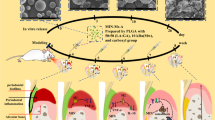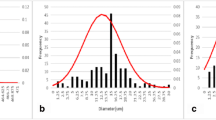Abstract
This study aimed at the preparation of a sustained-release 25-hydroxyvitamin D3 (25OHD) treatment for diabetic periodontitis, a known complication of diabetes. 25OHD-loaded polylactic acid (PLA) microspheres were prepared using oil-in-water emulsion–solvent evaporation method. The prepared microspheres exhibited intact surfaces, with average sizes ranging from 42.3 to 119.4 μm. The encapsulation efficiency ranged from 79.2% (w/w) to 88.5% (w/w), and the drug content was between 15.8% (w/w) and 17.8% (w/w). Drug release from the produced microspheres followed a near-to-zero-order release pattern and lasted over 10 weeks. In an in vitro model of diabetic periodontitis, the abnormal morphological changes and the decrease in the cell viability of bone marrow stromal cells could be effectively attenuated after the 25OHD-loaded microsphere application. Additionally, in a rat model of diabetic periodontitis, alveolar bone loss was inhibited and osteoid formation in the periodontium was promoted upon 25OHD-loaded microsphere treatment. In conclusion, 25OHD-loaded PLA microspheres may provide an effective approach for the treatment of this disease.






Similar content being viewed by others

REFERENCES
García-Hernández A, Arzate H, Gil-Chavarría I, Rojo R, Moreno-Fierros L. High glucose concentrations alter the biomineralization process in human osteoblastic cells. Bone. 2012;50:276–88.
O’Connell P, Taba M, Nomizo A, Foss Freitas M, Suaid F, Uyemura S, et al. Effects of periodontal therapy on glycemic control and inflammatory markers. J Periodontol. 2008;79:774–83.
Kim S, Kim K, Seo B, Koo K, Kim T, Seol Y, et al. Alveolar bone regeneration by transplantation of periodontal ligament stem cells and bone marrow stem cells in a canine peri-implant defect model: a pilot study. J Periodontol. 2009;80:1815–23.
Die L, Yan P, Jun Jiang Z, Min Hua T, Cai W, Xing L. Glycogen synthase kinase-3 beta inhibitor suppresses Porphyromonas gingivalis lipopolysaccharide-induced CD40 expression by inhibiting nuclear factor-kappa B activation in mouse osteoblasts. Mol Immunol. 2012;52:38–49.
Zhen D, Chen Y, Tang X. Metformin reverses the deleterious effects of high glucose on osteoblast function. J Diabetes Complications. 2010;24:334–44.
Gopalakrishnan V, Vignesh R, Arunakaran J, Aruldhas M, Srinivasan N. Effects of glucose and its modulation by insulin and estradiol on BMSC differentiation into osteoblastic lineages. Biochem Cell Biol. 2006;84:93–101.
Mealey B, Ocampo G. Diabetes mellitus and periodontal disease. Periodontology. 2007;44:127–53.
Venketaraman V, Lin A, Le A, Kachlany S, Connell N, Kaplan J. Both leukotoxin and poly-N-acetylglucosamine surface polysaccharide protect Aggregatibacter actinomycetemcomitans cells from macrophage killing. Microb Pathog. 2008;45:173–80.
Umeda J, Demuth DR, Ando E, Faveri M, Mayer M. Signaling transduction analysis in gingival epithelial cells after infection with Aggregatibacter actinomycetemcomitans. Mol Oral Microbiol. 2012; 27:23–33.
Dienelt A, Zur Nieden N. Hyperglycemia impairs skeletogenesis from embryonic stem cells by affecting osteoblast and osteoclast differentiation. Stem Cells Dev. 2011;20:465–74.
Bas A, Demirci S, Yazihan N, Uney K, Ermis KE. Nerium oleander distillate improves fat and glucose metabolism in high-fat diet-fed streptozotocin-induced diabetic rats. Int J Endocrinol. 2012;201(2):947187.
Sharma A, Bharti S, Kumar R, Krishnamurthy B, Bhatia J, Kumari S, et al. Syzygium cumini ameliorates insulin resistance and β-cell dysfunction via modulation of PPAR, dyslipidemia, oxidative stress, and TNF-α in type 2 diabetic rats. J Pharmacol Sci. 2012;3:205–13.
Watanabe K, Petro B, Shlimon A, Unterman T. Effect of periodontitis on insulin resistance and the onset of type 2 diabetes mellitus in Zucker diabetic fatty rats. J Periodontol. 2008;7:1208–16.
Pacios S, Kang J, Galicia J, Gluck K, Patel H, Ovaydi-Mandel A, et al. Diabetes aggravates periodontitis by limiting repair through enhanced inflammation. FASEB J. 2012;4:1423–30.
Hopfer U. Sorting out noncanonical, paracrine functions of vitamin D: focus on “Vitamin D receptor activation and downregulation of renin-angiotensin system attenuate morphine-induced T cell apoptosis”. Am J Physiol Cell Physiol. 2012;303:C592–4.
Mercer K, Wynne R, Lazarenko O, Lumpkin C, Hogue W, Suva L, et al. Vitamin D supplementation protects against bone loss associated with chronic alcohol administration in female mice. J Pharmacol Exp Ther. 2012;343:401–12.
Zhou X, Han J, Song Y, Zhang J, Wang Z. Serum levels of 25-hydroxyvitamin D, oral health and chronic obstructive pulmonary disease. J Clin Periodontol. 2012;39:350–6.
Filippella M, Faggiano A, Falchetti A, Colao A, Rosa C, Poti C, et al. Risk of fractures and bone abnormalities in postmenopausal women with type 2 diabetes mellitus. Clin Cases Miner Bone Metab. 2010;7:126–9.
Geng S, Zhou S, Glowacki J. Effects of 25-hydroxyvitamin D(3) on proliferation and osteoblast differentiation of human marrow stromal cells require CYP27B1/1α-hydroxylase. J Bone Miner Res. 2011;26:1145–53.
Brownfield LA, Weltman R. Ridge preservation with or without an osteoinductive allograft: a clinical, radiographic, micro-computed tomography, and histologic study evaluating dimensional changes and new bone formation of the alveolar ridge. J Periodontol. 2012;83:581–9.
Chang P, Chung M, Wang Y, Chien L, Lim J, Liang K, et al. Patterns of diabetic periodontal wound repair: a study using micro-computed tomography and immunohistochemistry. J Periodontol. 2012;83:644–52.
Shive M, Anderson J. Biodegradation and biocompatibility of PLA and PLGA microspheres. Adv Drug Deliv Rev. 1997;28:5–24.
Kobayashi D, Tsubuku S, Yamanaka H, Asano M, Miyajima M, Yoshida M. In vivo characteristics of injectable poly(dl-lactic acid) microspheres for long-acting drug delivery. Drug Dev Ind Pharm. 1998;24:819–25.
Chung T, Huang Y, Liu Y. Effects of the rate of solvent evaporation on the characteristics of drug loaded PLLA and PDLLA microspheres. Int J Pharm. 2001;212:161–9.
Patomchaiviwat V, Paeratakul O, Kulvanich P. Formation of inhalable rifampicin-poly(l-lactide) microparticles by supercritical anti-solvent process. AAPS PharmSciTech. 2008;9:1119–29.
Park S, Jeon Y, Haam S, Park H, Kim W. Preparation of chitosan microspheres using membrane emulsification and its size modelling. J Microencapsul. 2004;21:539–52.
Quenelle D, Staas J, Winchester G, Barrow E, Barrow W. Efficacy of microencapsulated rifampin in Mycobacterium tuberculosis-infected mice. Antimicrob Agents Chemother. 1999;43:1144–51.
Barrow E, Winchester G, Staas J, Quenelle D, Barrow W. Use of microsphere technology for targeted delivery of rifampin to Mycobacterium tuberculosis-infected macrophages. Antimicrob Agents Chemother. 1998;42:2682–9.
Khaled K, Sarhan H, Ibrahim M, Ali A, Naguib Y. Prednisolone-loaded PLGA microspheres. In vitro characterization and in vivo application in adjuvant-induced arthritis in mice. AAPS PharmSciTech. 2010;11:859–69.
Kim K, Dean D, Wallace J, Breithaupt R, Mikos A, Fisher J. The influence of stereolithographic scaffold architecture and composition on osteogenic signal expression with rat bone marrow stromal cells. Biomaterials. 2011;32:3750–63.
Giacaman R, Asrani A, Ross K, Herzberg M. Cleavage of protease-activated receptors on an immortalized oral epithelial cell line by Porphyromonas gingivalis gingipains. Microbiology. 2009;155:3238–46.
Kang J, de Brito Bezerra B, Pacios S, Andriankaja O, Li Y, Tsiagbe V, et al. Aggregatibacter actinomycetemcomitans infection enhances apoptosis in vivo through a caspase-3-dependent mechanism in experimental periodontitis. Infect Immun. 2012;6:2247–56.
Xu H, Zhong H, Liu M, Xu C, Gao Y. Lappaconitine-loaded microspheres for parenteral sustained release: effects of formulation variables and in vitro characterization. Pharmazie. 2011;66:654–61.
Cui F, Cun D, Tao A, Yang M, Shi K, Zhao M, et al. Preparation and characterization of melittin-loaded poly(dl-lactic acid) or poly (dl-lactic-co-glycolic acid) microspheres made by the double emulsion method. J Control Release. 2005;107:310–9.
ElMeshad A, Tadros M. Transdermal delivery of an anti-cancer drug via w/o emulsions based on alkyl polyglycosides and lecithin: design, characterization, and in vivo evaluation of the possible irritation potential in rats. AAPS PharmSciTech. 2011;12:1–9.
Ford Versypt A, Pack D, Braatz R. Mathematical modeling of drug delivery from autocatalytically degradable PLGA microspheres—a review. J Control Release. 2013;165:29–37.
Chen X, Ooi C. Hydrolytic degradation and drug release properties of ganciclovir-loaded biodegradable microspheres. Acta Biomater. 2008;4:1046–56.
Li X, Deng X, Yuan M, Xiong C, Huang Z, Zhang Y, et al. In vitro degradation and release profiles of poly-dl-lactide–poly(ethyleneglycol) microspheres with entrapped proteins. J Appl Polym Sci. 2000;78:140–8.
Hosogi Y, Duncan M. Gene expression in Porphyromonas gingivalis after contact with human epithelial cells. Infect Immun. 2005;73:2327–35.
Yang L, Wang J, Fan Y, Chen S, Wang L, Ma J. Effect of 1,25(OH)(2)D(3) on rat peritoneal mesothelial cells treated with high glucose plus lipopolysaccharide. Cell Immunol. 2011;271:173–9.
Peng X, Vaishnav A, Murillo G, Alimirah F, Torres K, Mehta R. Protection against cellular stress by 25-hydroxyvitamin D3 in breast epithelial cells. J Cell Biochem. 2010;110:1324–33.
Zhang W, Zhao S, Li Y, Peng G, Han P. Acute blood glucose fluctuation induces myocardial apoptosis through oxidative stress and nuclear factor-ĸB activation. Cardiology. 2012;124:11–7.
Li H, Xie H, Fu M, Li W, Guo B, Ding Y, et al. 25-Hydroxyvitamin D(3) ameliorates periodontitis by modulating the expression of inflammation-associated factors in diabetic mice. Steroids. 2012;78:115–20.
von Hurst P, Stonehouse W, Coad J. Vitamin D supplementation reduces insulin resistance in South Asian women living in New Zealand who are insulin resistant and vitamin D deficient—a randomised, placebo-controlled trial. Br J Nutr. 2010;103:549–55.
Branco-de-Almeida L, Franco G, Castro M, Dos Santos J, Anbinder A, Cortelli S, et al. Fluoxetine inhibits inflammatory response and bone loss in a rat model of ligature-induced periodontitis. J Periodontol. 2012;83:664–71.
Yiu Y, Yiu K, Siu C, Chan Y, Li S, Wong L, et al. Randomized controlled trial of vitamin D supplement on endothelial function in patients with type 2 diabetes. Atherosclerosis. 2013;227:140–6.
Dörr J, Ohlraun S, Skarabis H, Paul F. Efficacy of vitamin D supplementation in multiple sclerosis (EVIDIMS Trial): study protocol for a randomized controlled trial. Trials. 2012;13:15.
Van der Velden U, Kuzmanova D, Chapple I. Micronutritional approaches to periodontal therapy. J Clin Periodontol. 2011; 38(Suppl 11):142–58.
Garcia M, Hildebolt C, Miley D, Dixon D, Couture R, Spearie C, et al. One-year effects of vitamin D and calcium supplementation on chronic periodontitis. J Periodontol. 2011;82:25–32.
ACKNOWLEDGMENTS
This work was funded by grants from the National Natural Science Foundation of China (81200794) and the Science and Technology Foundation of Sichuan Province (2012SZ0144).
Author information
Authors and Affiliations
Corresponding author
Additional information
Hao Li and Qi Wang contributed equally to this work as first authors.
Rights and permissions
About this article
Cite this article
Li, H., Wang, Q., Xiao, Y. et al. 25-Hydroxyvitamin D3-Loaded PLA Microspheres: In Vitro Characterization and Application in Diabetic Periodontitis Models. AAPS PharmSciTech 14, 880–889 (2013). https://doi.org/10.1208/s12249-013-9978-5
Received:
Accepted:
Published:
Issue Date:
DOI: https://doi.org/10.1208/s12249-013-9978-5



